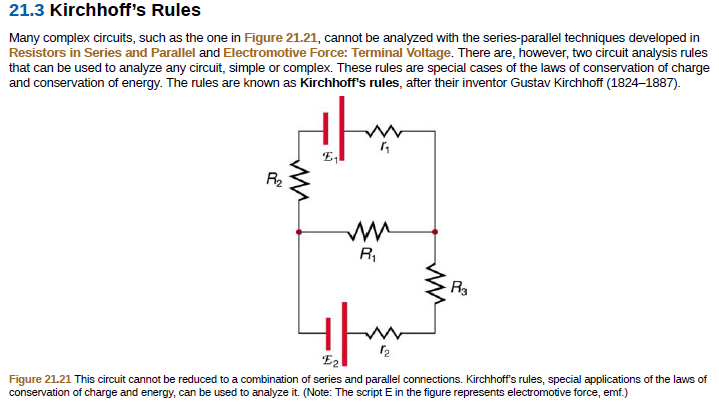21.3 Kirchhoff's Rules Many complex circuits, such as the one in Figure 21.21, cannot be analyzed with the series-parallel techniques developed in Resistors in Series and Parallel and Electromotive Force: Terminal Voltage. There are, however, two circuit analysis rules that can be used to analyze any circuit, simple or complex. These rules are special cases of the laws of conservation of charge and conservation of energy. The rules are known as Kirchhoff's rules, after their inventor Gustav Kirchhoff (1824–1887). E, R2 RI R3 E2 Figure 21.21 This circuit cannot be reduced to a combination of series and parallel connections. Kirchhoff's rules, special applications of the laws of conservation of charge and energy, can be used to analyze it. (Note: The script E in the figure represents electromotive force, emf.)
21.3 Kirchhoff's Rules Many complex circuits, such as the one in Figure 21.21, cannot be analyzed with the series-parallel techniques developed in Resistors in Series and Parallel and Electromotive Force: Terminal Voltage. There are, however, two circuit analysis rules that can be used to analyze any circuit, simple or complex. These rules are special cases of the laws of conservation of charge and conservation of energy. The rules are known as Kirchhoff's rules, after their inventor Gustav Kirchhoff (1824–1887). E, R2 RI R3 E2 Figure 21.21 This circuit cannot be reduced to a combination of series and parallel connections. Kirchhoff's rules, special applications of the laws of conservation of charge and energy, can be used to analyze it. (Note: The script E in the figure represents electromotive force, emf.)
College Physics
1st Edition
ISBN:9781938168000
Author:Paul Peter Urone, Roger Hinrichs
Publisher:Paul Peter Urone, Roger Hinrichs
Chapter20: Electric Current, Resistance, And Ohm's Law
Section: Chapter Questions
Problem 96PE: Integrated Concepts (a) Referring to Figure 20.34, find the time systolic pressure lags behind the...
Related questions
Question
100%
Kirchhoff’s Rules
• Analyze a complex circuit using Kirchhoff’s rules, using the conventions for determining the correct signs of various
terms.

Transcribed Image Text:21.3 Kirchhoff's Rules
Many complex circuits, such as the one in Figure 21.21, cannot be analyzed with the series-parallel techniques developed in
Resistors in Series and Parallel and Electromotive Force: Terminal Voltage. There are, however, two circuit analysis rules
that can be used to analyze any circuit, simple or complex. These rules are special cases of the laws of conservation of charge
and conservation of energy. The rules are known as Kirchhoff's rules, after their inventor Gustav Kirchhoff (1824–1887).
E,
R2
RI
R3
E2
Figure 21.21 This circuit cannot be reduced to a combination of series and parallel connections. Kirchhoff's rules, special applications of the laws of
conservation of charge and energy, can be used to analyze it. (Note: The script E in the figure represents electromotive force, emf.)
Expert Solution
This question has been solved!
Explore an expertly crafted, step-by-step solution for a thorough understanding of key concepts.
This is a popular solution!
Trending now
This is a popular solution!
Step by step
Solved in 3 steps with 4 images

Knowledge Booster
Learn more about
Need a deep-dive on the concept behind this application? Look no further. Learn more about this topic, physics and related others by exploring similar questions and additional content below.Recommended textbooks for you

College Physics
Physics
ISBN:
9781938168000
Author:
Paul Peter Urone, Roger Hinrichs
Publisher:
OpenStax College

Physics for Scientists and Engineers, Technology …
Physics
ISBN:
9781305116399
Author:
Raymond A. Serway, John W. Jewett
Publisher:
Cengage Learning


College Physics
Physics
ISBN:
9781938168000
Author:
Paul Peter Urone, Roger Hinrichs
Publisher:
OpenStax College

Physics for Scientists and Engineers, Technology …
Physics
ISBN:
9781305116399
Author:
Raymond A. Serway, John W. Jewett
Publisher:
Cengage Learning

